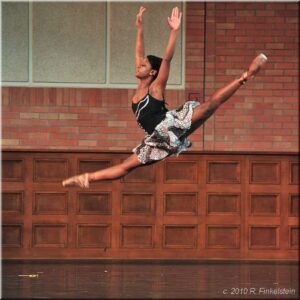Michaela DePrince: A Life of Triumph and Tragedy

Michaela DePrince, the renowned ballerina whose life journey from war-torn Sierra Leone to the world’s most prestigious ballet stages captivated millions, tragically passed away recently, leaving behind a legacy of resilience, grace, and inspiration. She was more than just a celebrated dancer; she was a symbol of hope, courage, and the power of dreams. In her brief yet remarkable life, DePrince broke barriers in the world of classical ballet, an industry often criticized for its lack of diversity. Her story, which began in unimaginable hardship, is one of overcoming odds, defying expectations, and transforming pain into beauty.
This article will explore her life—from her early years as an orphan in Sierra Leone to her rise as a celebrated ballerina—and reflect on the impact of her recent death.
Early Life: From War to Survival
Born as Mabinty Bangura on January 6, 1995, in Sierra Leone, DePrince’s early life was marked by violence, loss, and extreme hardship. She was orphaned at the age of three during the brutal civil war that devastated her country. Her father was killed by rebels, and her mother died of starvation shortly after. Michaela was left to the mercy of the orphanage system, a place where she faced relentless discrimination due to her vitiligo, a skin condition that causes depigmentation. Because of this condition, she was labeled as “the devil’s child” and treated as an outcast. Her condition, combined with the trauma of the war, made her early years extraordinarily difficult.
Despite the bleak environment, Michaela found a flicker of hope when she stumbled upon a magazine page that featured a ballerina en pointe. The image captured her imagination, and from that moment, Michaela dreamt of becoming a dancer. This unlikely dream sustained her, even as she faced hunger, loss, and isolation.
In 1999, when she was just four years old, Michaela’s life took a transformative turn. She was adopted by Elaine and Charles DePrince, an American couple, and moved to the United States with her new family. This marked the beginning of her journey toward a life of love, stability, and, eventually, ballet.
The Birth of a Ballerina
Once in the United States, Michaela was encouraged to pursue her passion for dance. She began training at The Rock School for Dance Education in Philadelphia, where her natural talent and dedication were immediately apparent. Despite facing challenges as one of the few Black dancers in a predominantly white ballet world, Michaela excelled. Her grace, strength, and technical prowess caught the attention of instructors and audiences alike.
Her breakthrough moment came when she was featured in the 2011 documentary First Position, which followed the lives of young ballet dancers preparing for the Youth America Grand Prix, one of the most prestigious ballet competitions in the world. The film showcased Michaela’s extraordinary talent and her determination to succeed, despite the obstacles she faced due to her race and background. Her performance in the documentary propelled her into the international spotlight.
From there, Michaela’s career soared. She went on to join the Dance Theatre of Harlem in 2012, an institution known for promoting diversity in ballet. In 2013, she joined the Dutch National Ballet in Amsterdam, one of the most prestigious ballet companies in the world. As a soloist with the company, she performed in some of the most iconic ballet productions, including The Nutcracker, Cinderella, and Giselle. Michaela’s rise to fame was not only a personal triumph but also a victory for representation in the ballet world, where dancers of color have historically been underrepresented.
Breaking Barriers and Advocating for Change
Throughout her career, Michaela DePrince was a vocal advocate for diversity and inclusion in ballet. She often spoke about the challenges she faced as a Black ballerina in an industry that is still grappling with issues of race and representation. Despite her undeniable talent, Michaela encountered racism, both overt and subtle. From being told she couldn’t play certain roles because of her skin color to being asked to wear makeup to “blend in” with her white colleagues, Michaela experienced firsthand the difficulties that many dancers of color face.
However, instead of allowing these challenges to discourage her, Michaela used her platform to advocate for change. She was determined to pave the way for future generations of dancers, ensuring that they wouldn’t face the same barriers she did. Michaela’s story became a source of inspiration for countless young dancers, particularly those who didn’t see themselves represented in classical ballet.
In addition to her advocacy work, Michaela was involved in numerous philanthropic efforts. She worked with War Child Holland, an organization that provides education and psychosocial support to children affected by war. Michaela’s own experiences as a child survivor of war made her deeply empathetic to the plight of children living in conflict zones. Her work with War Child was a testament to her commitment to giving back and using her platform for good.
A Tragic Loss
On September 10, 2024, the world was shocked and devastated by the news of Michaela DePrince’s untimely death at the age of 29. While the details surrounding her death remain private, the loss of such a bright and talented individual has sent ripples of sorrow throughout the dance community and beyond. Her death has left a void not only in the world of ballet but also in the hearts of those who were inspired by her story of perseverance and triumph.
Michaela’s passing is a stark reminder of the fragility of life, even for those who seem to embody strength and resilience. In the wake of her death, tributes poured in from all corners of the globe. Fellow dancers, choreographers, and fans took to social media to express their grief and celebrate the life of a woman who defied the odds and left an indelible mark on the world.
Legacy of Hope and Inspiration
Although Michaela DePrince is no longer with us, her legacy will endure. She will be remembered not only for her extraordinary talent as a ballerina but also for her unwavering commitment to breaking barriers and advocating for change. Michaela’s story is one of hope—a reminder that no matter where you come from or what challenges you face, dreams can be realized through hard work, determination, and the courage to believe in yourself.
Her memoir, Taking Flight: From War Orphan to Star Ballerina, which she co-wrote with her mother Elaine DePrince, will continue to inspire readers for generations to come. The book chronicles Michaela’s journey from the horrors of war to the heights of the ballet world and serves as a powerful testament to the human spirit’s capacity for resilience and transformation.
In the end, Michaela DePrince’s life was one of triumph. She overcame unimaginable hardship, shattered barriers, and achieved what many deemed impossible. Though her time on this earth was tragically cut short, her story will live on, inspiring dancers, dreamers, and fighters everywhere to keep pushing forward, no matter the odds.
The ballet world may have lost one of its brightest stars, but Michaela DePrince’s light will continue to shine through the lives she touched, the barriers she broke, and the dreams she inspired.
Sandip Soparrkar holds a doctorate in world mythology folklore from Pacific University USA, an honorary doctorate in performing arts from the National American University, He is a World Book Record holder,
a well-known Ballroom dancer and a Bollywood choreographer who has been honored with three
National Excellence awards, one National Achievement Award and Dada Saheb Phalke award
by the Government of India. He can be contacted on sandipsoparrkar06@gmail.com






